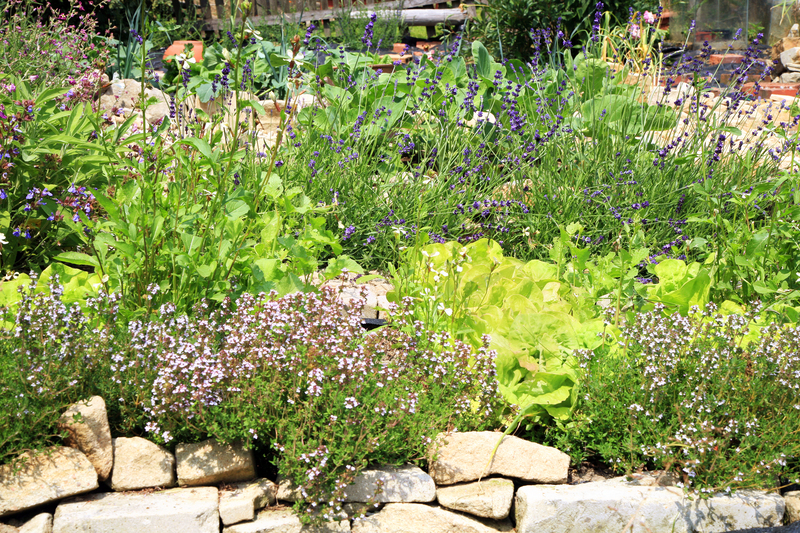Container gardening: a versatile growing method
Posted on 06/09/2025
Container Gardening: A Versatile Growing Method
Container gardening is more than just a trend--it's a flexible and innovative approach to growing plants that suits almost any lifestyle and living arrangement. Whether you're a veteran gardener or an urban dweller with limited space, container gardening offers a practical solution to cultivate herbs, flowers, vegetables, and even small trees. In this comprehensive article, we'll delve into all aspects of container gardening, exploring its benefits, various techniques, plant choices, and expert tips for success. Keep reading to discover how this versatile growing method can transform your space and enrich your life.

What is Container Gardening?
At its core, container gardening simply means growing plants in containers or pots instead of directly in the ground. These containers can range from traditional terracotta pots to creatively repurposed items like buckets, barrels, baskets, or even old boots! This adaptable gardening method allows enthusiasts to exercise creativity not only in plant selection but also in how and where they grow them.
Key Features of Container Gardening
- Mobility: Containers can be moved to take advantage of sunlight, avoid harsh weather, or simply change aesthetics.
- Space-saving: Perfect for small patios, balconies, rooftops, or any area where traditional gardening isn't possible.
- Soil control: Gardeners have complete control over soil type and quality, helping to avoid soil-borne diseases.
- Season extension: Some containers can be moved inside or to sheltered spots to extend the growing season.
- Versatility: A broad range of plants--from annuals and perennials to vegetables, fruits, and even shrubs--can be grown in containers.
The Benefits of Container Gardening
There's a reason why container gardening techniques have surged in popularity. From practical considerations to creative freedom, the perks are many:
1. Accessibility
Container gardening is ideal for people with mobility issues or limited physical strength. Elevated planters can be placed on tables, window sills, or stands, reducing the need for bending, digging, or heavy lifting.
2. Pest and Disease Management
By isolating plants in containers, gardeners can more easily control pests and reduce the risk of soil-borne diseases spreading throughout their garden. It also makes quarantine and targeted treatment of affected plants more straightforward.
3. Urban and Indoor Gardening
Container gardening enables apartment dwellers or people with limited outdoor space to enjoy the satisfaction of growing their own produce or floral displays. Many indoor plants thrive in pots, bringing green life indoors all year round.
4. Experimentation and Flexibility
Because containers are easy to move and replace, gardeners can experiment with combinations, plant varieties, and gardening setups without long-term commitment. If one arrangement doesn't work, simply adjust it!
Choosing the Right Containers
Not all containers are created equal. The vessel you choose can dramatically affect your plant's health and growth. Here's what to consider when selecting containers:
- Size: Larger containers retain soil moisture longer and give roots room to grow. However, small containers are well-suited for herbs and succulents.
- Material: Common materials include plastic (lightweight, affordable), ceramic (decorative, insulating), terracotta (porous, traditional), metal (durable but can overheat), and wood (natural but can rot without care).
- Drainage: Proper drainage holes are crucial to prevent waterlogging, which causes root rot.
- Shape and Color: Deep pots are necessary for plants with long roots, and lighter-colored pots reflect sunlight, keeping roots cool in summer.
Creative Container Ideas
Innovative gardeners often repurpose unexpected household items, such as:
- Old teapots or colanders
- Wooden crates or wine barrels
- Hanging baskets fashioned from recycled plastic bottles
- Painted buckets or retro suitcases
*Just ensure the container has adequate drainage!*
Soil and Potting Mixes for Container Gardening
Soil selection is critical in container gardening. You can't just scoop dirt from your yard and expect great results--native soil often contains pests, weeds, and poor drainage. Instead, opt for specialized potting mixes.
- Soilless Mixes: Lightweight mixes containing peat, coir, perlite, and vermiculite. Excellent for most container plants.
- Moisture Retention: Additives like water-retaining granules help maintain even moisture levels.
- Organic Amendments: Compost, worm castings, or slow-release organic fertilizers provide sustained nutrients.
Best Plants for Container Gardening
One of the joys of growing in containers is versatility in plant selection. Choices are virtually limitless, but some plants do particularly well:
Edibles
- Herbs: Basil, parsley, mint, chives, cilantro, thyme
- Vegetables: Tomatoes, peppers, lettuce, spinach, carrots, radishes, beans
- Fruits: Strawberries, dwarf blueberry bushes, citrus trees (dwarf varieties)
- Greens: Kale, arugula, Swiss chard
Ornamentals
- Annual Flowers: Petunias, marigolds, impatiens, pansies, geraniums
- Perennials: Hostas, daylilies, lavender, ornamental grasses
- Small Shrubs: Boxwood, dwarf azalea
- Succulents and Cacti: Perfect for low-maintenance, drought-tolerant displays
Tall and Vertical Plants
- Climbers: Sweet peas, morning glories, pole beans, clematis (with the addition of a trellis)
- Dwarf Trees: Certain varieties of apple, lemon, or fig can thrive in large containers
How to Start a Container Garden: Step-by-Step Guide
1. Select Your Containers
Choose pots based on your chosen plants, location, and aesthetic preferences. Make sure every container offers good drainage.
2. Prepare the Potting Mix
Use a high-quality commercial potting mix suited to your plants. Consider mixing in organic matter or slow-release fertilizer.
3. Plant Selection and Arrangement
Pick plants that thrive in similar conditions (sun, water, soil). For a striking display, combine:
- Thrillers (tall centerpieces)
- Fillers (bushy medium-height plants)
- Spillers (trailing plants that cascade over the edges)
4. Plant Properly
Fill each container with moistened potting mix, leaving a gap at the top. Plant at the same depth as the nursery container, then water thoroughly.
5. Provide Proper Care
Regular watering is key. Container plants often dry out faster than ground beds, especially in hot weather. Fertilize according to plant needs and always remove faded flowers and dead foliage to encourage growth.
Special Container Gardening Tips and Techniques
Watering Strategies
- Check soil moisture frequently, especially in summer.
- Self-watering containers can help maintain even moisture.
- Group containers together to reduce evaporation and help create a microclimate.
Fertilizing Containers
- Frequent watering can leach nutrients, so regular feeding is essential.
- Use a liquid fertilizer every 2-4 weeks or add slow-release granules at planting time.
- Organic options (compost tea, fish emulsion) can be gentle and effective.
Seasonal Swaps
- Update containers with seasonal plants for year-round interest.
- Try spring bulbs in early containers, vibrant summer annuals mid-year, and mums or ornamental cabbages in autumn.
Dealing with Extreme Weather
- In hot climates, opt for light-colored pots and provide midday shade.
- Move frost-tender plants indoors or to sheltered areas before winter freezes.
- Insulate containers with bubble wrap, mulch, or burlap during unexpected cold snaps.
Designing Your Container Garden
The possibilities for garden design are endless with container gardening. Here are some expert design ideas for visually stunning and functional container displays:
- Monochrome Themes: Use plants of varying tones within a single color family for sophisticated harmony.
- Height Variation: Layer plants by height and use pedestals or shelves for additional dimension.
- Edible Ornamental Mix: Combine culinary herbs with colorful flowers for an attractive and practical display.
- Patio Privacy: Arrange tall containers with bamboo or ornamental grasses to create a living privacy screen.
- Vertical Gardening: Use stackable planters, shelves, or wall-mounted pots to maximize vertical space.
Common Problems and Solutions in Container Gardening
- Overwatering: Symptoms include wilting, yellow leaves, and soggy soil. Always ensure proper drainage and reduce frequency accordingly.
- Pest Infestation: Aphids, spider mites, and slugs can affect container plants. Inspect regularly and treat with organic pest control methods when needed.
- Nutrient Deficiency: Pale leaves or stunted growth could mean a lack of nutrients--feed with a balanced fertilizer.
- Rootbound Plants: Roots encircling the pot and stunted growth are signs it's time to repot in a larger vessel.
- Inconsistent Growth: Group plants with similar needs in the same container and adjust care as required.

Sustainable Container Gardening Practices
With increasing environmental awareness, many gardeners seek sustainable options for their container gardens:
- Reuse and Recycle: Repurpose containers and use biodegradable or recycled pots whenever possible.
- Organic Methods: Use organic soils, mulches, and natural pest deterrents.
- Water Conservation: Install drip irrigation, use mulch to retain moisture, and collect rainwater for watering.
- Composting: Add homemade compost to potting mixes to enrich soil and reduce waste.
Conclusion: Maximize Your Green Space with Container Gardening
To sum up, container gardening stands out as the most adaptable gardening technique for all skill levels and living situations. Whether you have a sprawling yard or a tiny balcony, this method can help you:
- Grow healthy, fresh produce and beautiful flowers
- Express your creativity
- Enhance your home's aesthetic
- Connect with nature in any available space
With the right containers, quality soil, smart plant choices, and attentive care, your container garden will thrive season after season. Don't let limited space curb your gardening dreams--embrace the versatility of container gardening and enjoy a lush mini oasis wherever you live!
Ready to get started? Pick your pots, choose your plants, and begin your container gardening adventure today!
```


